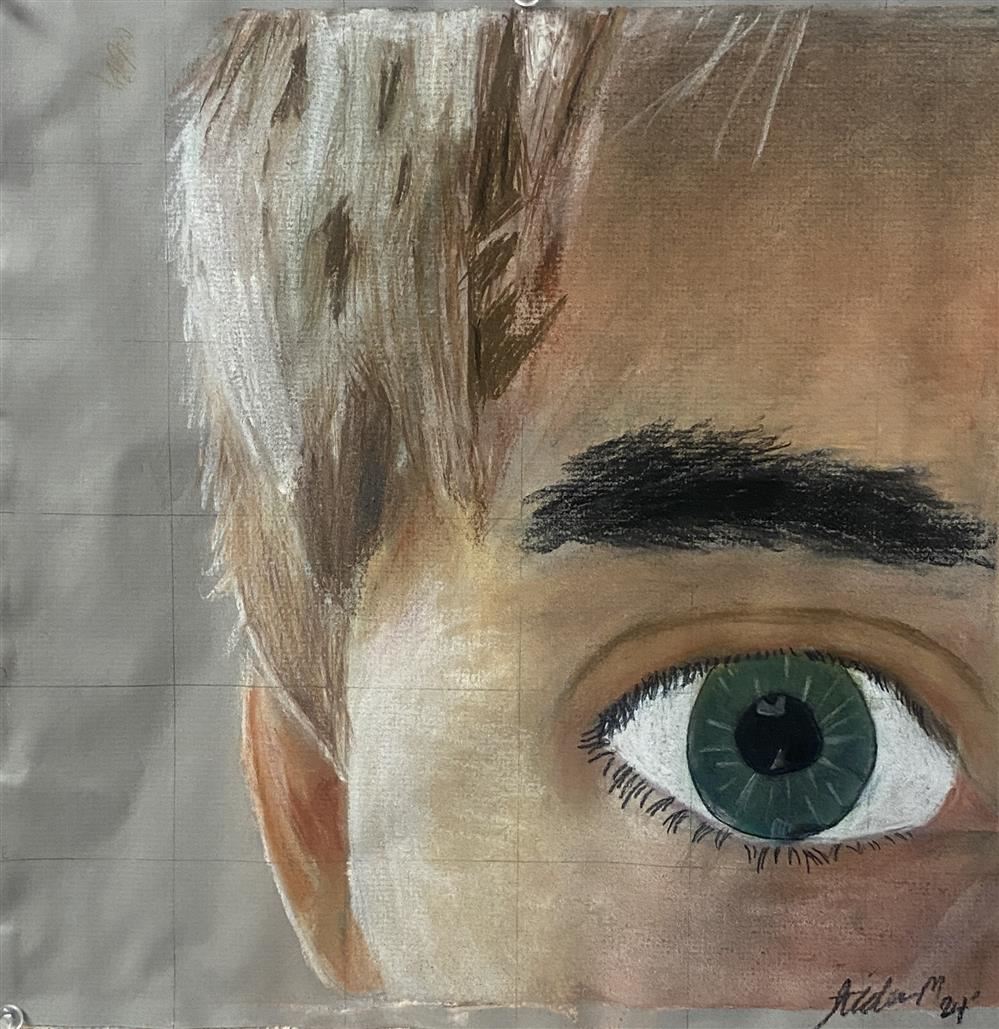Hoon, Dustin--Art
Page Navigation
- Big Sky High School
- Drawing One

Drawing I Imagine, See, AND make DUSTIN HOON (INSTRUCTOR) dmhoon@mcps.k12.mt.us 406-728-2400 ext: 8069
-
Drawing I
Imagine, See, AND make
DUSTIN HOON (INSTRUCTOR) dmhoon@mcps.k12.mt.us 406-728-2400 ext: 8069
Dustin Hoon
‘Fatherhood Series #1’ 2011
Class Considerations se:
-
TO consider what “art” means
-
To create and share creations
-
To prepare for the world of “visual art” out of the high-school environment
Think of what we are exploring in terms of a conceptual triad
Student concerns throughout the semester:
-
Aesthetics: Consider why it is important to think about what is beautiful and/or ugly etc?
-
Creativity: how, why, what, where, and for whom are you making art?
-
Exhibition: Where will you show your work, and how will you create a body of work to show?
Student at work in Mr. Hoon’s Drawing class 2011
Student expectations:
-
Respect: students will show respect for themselves and others in class.
-
Students will make art and articulate what it is, why it exists, and what it is about throughout the duration of the class. Students will create a body of work.
-
Students will read literature about art, write about art, critique art, and discuss art with others in class. The student must have a sketchbook to this end.
-
Students will read and discuss the civility rubric with Mr. Hoon.
-
Students will read, respond to and use Mr. Hoon’s Google Classroom to find lesson plans, resources, ideas and opportunities.
-
Students will read and discuss art standards and summative rubrics with Mr. Hoon.
Grading Procedure
.
Your instructor is of the opinion that quality of product is more important than speed of completion. Please consider what quality means to you. Mr. Hoon will accept late work with no penalty. Drawing projects are compared to a Standards-Based 0-4 scale rubric, and all projects may be revised and resubmitted through the entire semester for re-evaluation. Evidence of participation is gauged frequently relying on photographs of participation uploaded to Google Classroom. This formative assessment is graded 0 or 10 points, pass or fail and is not compared to a rubric.
All work will have an official due date in order for your instructor to assess, evaluate, and comment on your work. Also, consider trying to meet the due dates in order to get points for critique.
Types of Assignments:
Sketchbook Work: Notes, Drawings, Writing, ETC.
A Minimum of Five Art Projects with Specific Goals and Learning Targets
Personal Drawings –Any Media, Any Subject
Tutorials and Teacher Led Drawing Activities (Note: If a student misses the activity/tutorial day, Mr. Hoon has provided scanned instructions and/or YouTube tutorials that cover similar skills and techniques that students can do at home and submit
Critique: Discussion and group assessment of student work.
All of your work will support and evolve into a body of work (or a Portfolio), which will be exhibited for public view
Be Responsible, Respectful, Be Resilient
Working Well in the Art Studio
Every students’ relative civility is measured separately from the art that they make. Notes on positive and negative behaviors are recorded on the civility rubric and communicated with families and entered as a separate grade at the end of the semester. The civility rubric is aligned with the national standards for the visual arts. Please read the following:
Civility Rubric
Effort and Classroom Civility Assessment Tool.
Health and Safety Measures are
Critical to Success, Safety and Continued In-Person Learning. Proper Use of Personal Protective Equipment.
Students
will remain at workstations - NOT HOVERING BY THE DOOR, AIMLESSLY
CIRCULATING THROUGHOUT CLASS, OR HOVERING BY ANOTHER STUDENT or
TEXTING/CALLING FRIENDS & FAMILY. Cell phones are stored in the caddy or with the teacher at the start of class. Cell phones are checked into the teacher when exiting the classroom.
The student is required to photograph and upload their daily progress.
To Google classroom as a critical measurement of their relative participation.
And evidence of their experience.
Anchor Standard 3:
Refine and complete artistic work. • Enduring Understanding: Artists and
designers develop excellence through practice and constructive critique,
reflecting on, revising, and refining work over time. • Essential Question:
What role does persistence play in revising, refining, and developing work? How
Do artists grow and become accomplished in art forms? How does collaboratively
Reflecting on a work helps us experience it more completely?
○ I can work
within a studio environment ensuring the safety of myself and others.
-

